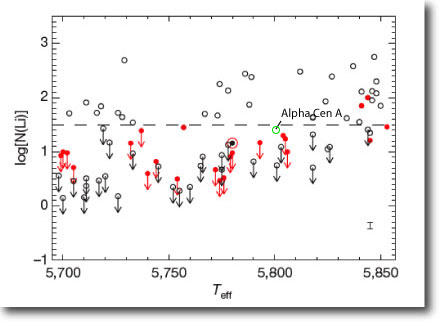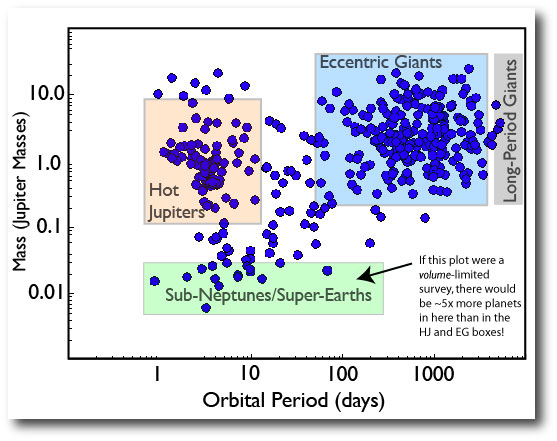lithium-induced speculations
Israelian et al’s Nature paper on the planet-stellar lithium correlation (featured in last week’s post) caused quite a stir in the community. The depletion of lithium in the atmosphere of a solar-type star seems to be a prerequisite for the presence of a detectable planetary system. Here’s the paper’s plot again, this time, with Alpha Cen A added for effect. 
Had Israelian et al.’s paper come out a decade ago, much of the ensuing hubub would have focused on the fact that low lithium abundance is an effective signpost to planetary systems. Nowadays, though, mere detection of new planets is passé. Everyone knows there are tons of planets out there. Focus is shifting to finding the lowest-mass (and preferably transiting) planets around the brightest M, K, and G main sequence stars in the Sun’s neighborhood. There is a short, highly select, list of worlds that have been, and will eventually be, followed up to great advantage with HST, Warm Spitzer, and JWST. All of the Sun’s most alluring stellar neighbors are under heavy and ongoing scrutiny, and in fact, it’s these particular stars (in the form of the HARPS GTO list) that enabled discovery of the planet-lithium correlation.
So planet-finding utility aside, the intense interest in the planet-lithium effect stems from the fact that it’s guaranteed to be imparting an important clue to the planet-formation process.
With over 400 planets known, clear populations are starting to emerge. It’s remarkable that the strength of the lithium-planet correlation seems to be largely independent of the masses and periods of the planets themselves. The mass-period diagram for planets, on the other hand, shows that there are at least three distinct concentrations of planet formation outcomes:
It’s important to keep in mind that Israelian et al.’s correlation holds over only a very narrow range of stellar temperature. The M-dwarfs (Gliese 581, Gliese 876), the K-dwarfs (HD 69830, Alpha Cen B), and the F-dwarfs (Upsilon Andromedae) all fall outside the band of utility. This dovetails nicely with standard models of stellar evolution that suggest the amount of Lithium depletion in stars with masses very close the the Sun (that is, stars falling in the narrow effective temperature range of the above plot) depends sensitively on both the efficiency of convection and also on rotational mixing. That is, the stars that show the lithium-planet effect, are exactly the stars where subtle differences in properties seem to generate a big effect on lithium abundance.
After writing last week’s post, I got an e-mail from Jonathan Irwin (of MEarth fame) who makes several interesting points:
The low lithium could be more of a coincidence resulting from the long-lived circumstellar disks that are presumably needed to form planets.
Mediation of the stellar rotation rates by long-lived disks is thought to be responsible for generating the wide dispersion in rotation rates observed in open clusters around 100Myr age, and there have been suggestions (e.g. Denissenkov et al.’s paper that appeared on astro-ph 2 weeks ago) that the slowly-rotating stars evolve developing some degree of decoupling of the rotation rates of their radiative core and convective envelope, whereas the rapidly-rotating stars evolve more like solid bodies.
Bouvier (2008) has suggested that the shear at the radiative convective boundary resulting from this could mix lithium into the interior more efficiently, and thus could result in lower lithium for stars that were slow rotators, preserving evidence of their rotational history even though the final rotation rates all converge by the solar age. Some evidence for this last part exists in the form of a correlation between rotation and lithium in young open clusters such as the Pleiades.
A hypothesis along these lines seems quite appealing to me. As long as a protoplanetary disk is present, and as long as its inner regions are sufficiently ionized, then there’ll be a connection between the stellar magnetic field and the magnetic field of the disk. To a (zeroth) degree of approximation, the equations of ideal MHD allow us to envision the situation as consisting of a rapidly rotating star connected to a slower-rotating disk by lot of weak rubber bands. The net effect will be to slow down the stellar rotation to bring it into synch with the rotation at the inner edge of the disk.
Trying to sound like a tough-guy, I stressed the importance of predictions in last weeks post. If Irwin’s hypothesis is correct, then the formation of the Mayor et al. 2008 planet population is associated with disks that contain lots of gas, even in regions interior to R~0.1 AU. I’d thus expect that the “super Earths” are actually “sub Neptunes”, and that we can expect considerable H-He envelopes for the majority of these planets.
Another speculative prediction concerns the stars that aren’t depleted in lithium. In Irwin’s picture, these stars had short-lived disks and lost their gas relatively rapidly. This shouldn’t hinder the formation of terrestrial planets, but one would expect that the final configurations of the rocky planets would sport higher eccentricities, as there was little or no gas to damp the orbits down during the final stages of terrestrial planet accretion (see this paper for more on this).















